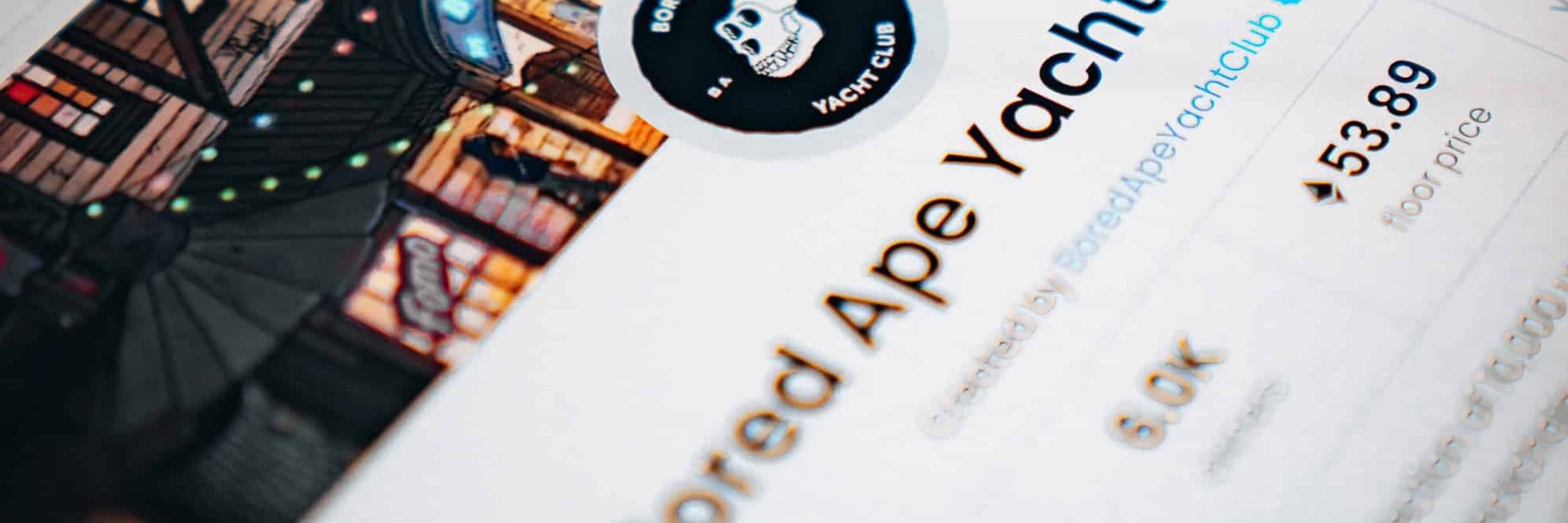
NFTs are shifting from a buzzword to business model, but there are key considerations that have to be addressed by brands.
It’s a picture of a monkey with a three-day growth. It’s wearing a psychedelic ship captain’s hat, an unattractive gold bomber jacket, and for reasons unclear, it appears to be holding a dagger in its teeth.
As art goes, it’s not wildly inspiring — but as a Bored Ape NFT, it’s worth about $1.9 million in USD, or 550 in wrapped Ethereum (wETH) cryptocurrency.
Put another way, it sells for several times the price of most original Banksy artworks, or as much as a custom-made, 1951 Mercury coupe.
For many in the business world, the surge in interest in NFTs — or non-fungible tokens — seems to defy commercial logic.
After all, the most high-profile examples, like Bored Ape Yacht Club #8135, seem vaguely ridiculous as either a collectable or investment option, even if the cheapest of the 10,000 pictures created by Yuga Labs last year sells for a minimum of $300,000.
But with an estimated $25 billion in NFTs traded in 2021, the impetus to understand this market and find a way to participate is growing.
Increasingly, these blockchain-enabled digital tokens are popping up in unusual places as legitimate businesses look to understand and develop an alternate digital income stream.
Baker Tilly Canada’s digital team specialises in working with clients who have digital assets, including digital currency, NFTs and other emerging areas that involve tokenisation and blockchain, and was developing tokens even before they hit the headlines.
Deepak Upadhyaya, who leads the Digital Technology and Risk Team, says that while NFTs might be a new investment vehicle, they work on the same levers that apply to many other kinds of investment — such as rarity and exclusivity.
“It’s really the rarity of the product that creates so much excitement. You are owning something that’s unique, that’s valuable and that nobody else in the whole world has owned,” he says.
“What is so exciting about the NFT space is the fact that something is unique, and there are only a set number of those tokens or collectables. You are part of an exclusive club of people that has access to it.
“If we take the Bored Ape Yacht Club, for example, that’s such a status symbol. It’s equivalent to owning other valuable pieces of art by any master painter. It’s a show of pride and a show of status that you are able to own that collectible.''
“On the flipside, for the seller it is a huge opportunity. The other day I was listening to a discussion about a 16-year-old artist who nobody knew, and no one was recognising his talent and his capability. That was until he minted an NFT and it led to huge excitement in his work.
“It works out both ways — it gives an artist an opportunity to express themselves and for the buyer, it gives them an opportunity to own something that is a unique artifact.”
“In addition to just art and the associated revenue factors of rarity and exclusivity, a number of NFT’s are associated with real world physical objects e.g. real estate or entrance to exclusive events and clubs” this also adds value and allows the owners to have something physical.
Making money within a digital environment is possible — after all, cryptocurrency funds do it every day — but the process of turning NFTs from a buzzword to business model is also gaining traction.
Big brands are moving rapidly into the space, in part fearing they will miss the moment.
Among those testing the waters are fashion brands, who are hoping to move beyond simply selling images of their clothing as NFTs to finding ways of broadening both the range of goods they can sell and the market they reach.
Gucci, for example, auctioned off a three-minute video clip for charity in 2021, making $25,000, and sells a set of digital sneakers for avatars for just $12, rather than the $1500 required for actual shoes.
Neuno works with brands to sell what it calls “digital wearables: start building out your 3D wardrobe for the metaverse”.
Shoe company Vans and clothier Ralph Lauren both sell digital gear on social app Roblox.
Sporting brands are also exploring their options, whether it is tokenising limited edition video highlights from Ultimate Fighting Championship fights and NBA basketball games, while the Australian Open sold NFTs for virtual squares on the tennis court, presenting the match tennis ball to the token owners wherever a winning shot landed.
“There is a whole overlap between the digital world and the physical world, and that overlap is really taking off,” Mr Upadhyaya says.
“For people that spend a lot of time in the digital world, these things have an intrinsic value in a digital environment. So if you think about something like sneakers, every Gen-Z and Gen-Alpha wants unique sneakers. Now Nike has capitalised on that so that you can not only get some Nike NFTs or digital sneakers, you can also have a physical prototype of the shoes designed by yourself.
“We are starting to experiment quite a lot on the implications of the Metaverse and what it means for businesses.”
Real world value for digital tokens
For some industries, Mr Upadhyaya says an immediate opportunity is to use NFTs and the blockchain technology behind them as a form of exchange in the real world for things of value.
“We’re working with a client right now in Canada that produces very unique wines, and they also buy from some of the other regions of the world where they mature it, cask it and bottle it,” he says.
“For them, proving ownership is a critical component so it is a real-world use case. You are not necessarily using an NFT to gain anything as a collectable but to prove the authenticity of the product.”
With wine fraud impacting up to 25 per cent of the global wine market, proof translates to value.
“We’re minting tokens that are tied in with the UPC, and a blockchain record,” Mr Upadhyaya says.
“The client is able to scan their barcode and it will tell them the specific batch number, the specific type of grape, the specific area of growth, and ensures that that record can be authenticated and traced to establish ownership.”
Baker Tilly Canada is itself experimenting with NFTs, looking at tokens that can be redeemed for consulting services as part of a push to help clients understand the market and potential.
“The idea is to raise money for charity, so we will be having an auction and minting 10 NFTs and the owner can redeem the token for consulting services,” he says.
“It’s a fun way for someone to be able to contribute to charity, understand a little bit about NFTs and see how they are applicable in the client’s specific environment.
“You might never think of consulting services as something that you could make NFTs or tokens out of, but it showcases how businesses can digitise their services or products and create a separate source of revenue.”
Entering, eyes wide open
Despite global interest in NFTs, though, businesses need to consider their entry carefully.
One risk for brands is balancing the desire to reach NFT buyers, often young and crypto-aware, without alienating their traditional customer base.
Gucci’s NFTs are sold in conjunction with digital collectable group Superplastic, which offers the advice “NFTs are yer membership ticket to tha universe” — a little off-brand for the high-end luxury brand.
Brands also have to consider issues of security.
Though blockchain tokens are frequently secure, as the data is decentralised and a permanent record of ownership created, the fast-moving world of crypto and NFT acts as a honeypot for scammers.
One common approach is to ‘remint’ NFTs that have already sold out, with scammers posing as legitimate NFT projects and taking payment in Ethereum for NFTs that don’t exist.
Another is the practice of ramping up NFT prices by ‘selling’ NFTs to buyers for significant sums, even if the buyer is actually the seller in disguise.
Of course, even traditional art sales are subject to such practices, but the novelty of NFT scammers garners much more attention.
A third challenge lies in debates over intellectual property rights, as shown by recent cases such as the battle between director Quentin Tarantino and film studio Miramax over NFTs based on the film Pulp Fiction.
A host of artists report their work being appropriated and sold as NFTs, without recognition of their original copyright or agreement that ownership has been transferred.
For business, it means going into the market with eyes open, and understanding the legal and commercial implications of minting, buying or trading in NFTs.
“Like anything else, it’s a question of determining the risk versus the benefit,” Mr Upadhyaya says.
“I think the infrastructure and the technology has stabilised quite a bit but there is still some risk associated with this market. You need to know if you can manage that risk — what your acceptable tolerance level is for that risk.
“If I reflect back on the example we are using at Baker Tilly Canada where we are creating services in return for tokens, we are not really losing anything if that token gets lost. The worst that can happen is we might lose a couple of hours of revenue.
“But in our case, we balance that with the opportunity to create excitement and value with tokenisation. Where’s the potential downside when you look at it like that?”









